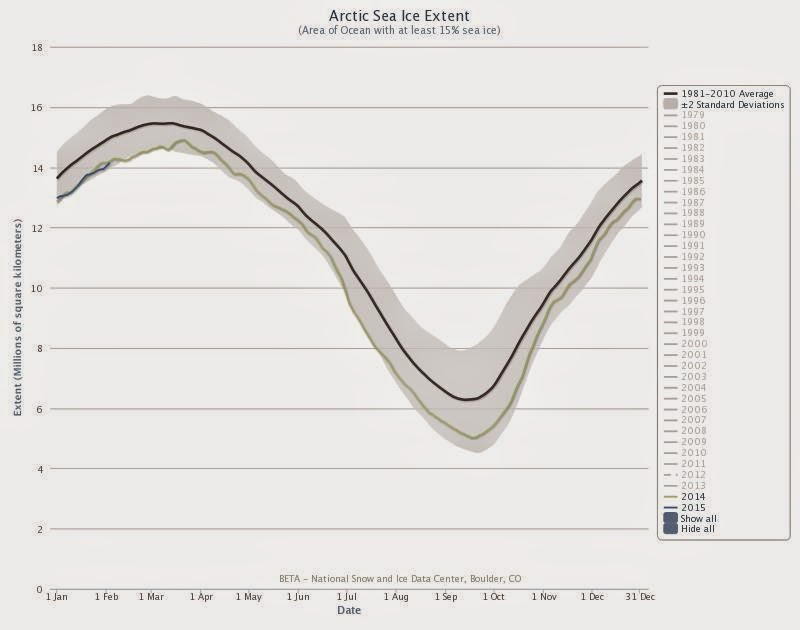Erratic as normal: Arctic sea ice loss expected to be bumpy in the short term states, "Arctic sea ice extent plunged precipitously from 2001 to 2007, then barely budged between 2007 and 2013."
Let's look at the data. Here is a plot of the Arctic sea ice extent as measured in September every year.
 |
| Source: NSIDC |
What you can easily see is the downward trend in the extent, represented by the dashed line. Now, take a look at the two periods in question. First, the 2001 to 2007 data shows it went from about -10% to -35%. Then, the 2007 to 2013 period shows it went from -35% to -15%. Apparently, the data supports the conclusion of the paper's authors.
But, I contend this is what is known as cherry picking - picking your data points to give the results you are looking for. I have frequently criticized deniers for doing this and it is only fair to criticize scientists for doing it, as well. How do I justify calling it cherry picking? Well, let's take a look at some other starting and ending points.
If we examine the period 2001 to 2009, we get the ice extent went from about -10% to -15%. Now, if we examine the period of 2009 to 2012, we get the ice extent went from -15% to -45%. That is a completely different result! Using these data points, I can say the ice extent was fairly steady from 2001 to 2009 but dropped at an alarming rate from 2009 to 2012, opposite of the claims made in that paper. Again, it is all about picking your starting and ending points.
Since I have just accused the authors of cherry-picking, I find it very interesting when they state,
"To understand how climate change is affecting the Arctic, you cannot cherry pick short stretches of time," Kay said. "Seven years is too short."In this regard, they are very correct and I am in agreement with them, but I still maintain they cherry picked the data to get the results they wanted. Using slightly different starting and ending points produces exactly opposite results.
That is why we must use long-term data and determine what the trend is. There is going to be a great deal of variability from year to year, not just in sea ice but in any kind of climate data we get. The climate is extremely complex, possibly the single most complex science of all. There is not just one thing at work, there is essentially every single field of physics at play. Everything from quantum mechanics and particle physics to space science and astronomy with everything in between is involved with climate science.It only stands to reason we should see variability in the short term and we need to focus our attention on the long term
As for any claim the Arctic sea ice is making a 'recovery,' take a look at this plot of the current sea ice:
 |
| Source: NSIDC |
There is no 'recovery' underway. The sea ice is disappearing and, even with yearly variability included, it continues to do so.





0 comments:
Post a Comment